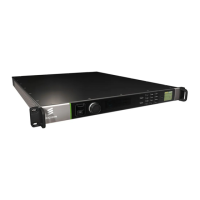3.7.18 How to Configure Output Transport Streams with Internal Reflex Support
3.7.18.1 About Internal Reflex
Internal Reflex (Reflex) is the statistical multiplexing system provided by Ericsson.
Reflex works on a group of components (called a Reflex group), and monitors the bit
rate demand of each component within the group on a frame-by-frame basis. It
adjusts the bit rate allocated to each component to ensure that the picture quality is
constantly optimized.
A Reflex group can use the available bit rate within a Transport Stream, or it can
have a manually set bit rate. Either way, the sum of the bit rates of the components
within the group never exceeds the Reflex group bit rate.
Internal Reflex does not require an external control entity for correct operation. As a
trade-off, internal Reflex can only control the bit rates of internally generated
components.
Reflex requires a valid AVP/SWO/REFLEX license for each option card whose
output video stream is included in a Reflex group.
To set up Reflex operation, first a Reflex group must be created and components
have to be added to it. Then the Reflex group parameters must be set up. Finally,
the Reflex parameters for each component must be customized.
3.7.18.2 Internal Reflex Visualization
Once all parameters for all channels (components) are set, the Reflex operation can
be monitored on a chart under the Bit rates area in the Reflex Group accordion of
the Properties widget.
The chart is only updated if there are no pending changes. To commit any pending
changes and have the chart updated by the web user interface, click on the Apply
button in the top right corner of the page.
To create a Transport Stream with Reflex support, do the following:
1. Browse to the Service Configuration page.
2. In the Outputs widget, create a Transport Stream.
3. Right click on the newly created Transport Stream, and select Add Reflex
Group. (You can also choose the Add Reflex Group option from the Edit
menu.)
4. Select the Reflex group you want to add one or more services to.
5. Right click on the selected Reflex group, and choose Add Service from the
context menu. (You can also choose Add Service option from the Edit menu.).
6. Now add components to the required services by dragging them from the Inputs
widget or selecting them in the Inputs widget, choosing Edit > Copy, selecting
the service in the Outputs widget, and choosing Edit > Paste.

